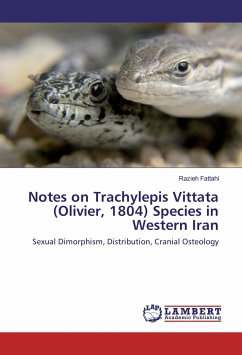
Notes on Trachylepis Vittata (Olivier, 1804) Species in Western Iran
Sexual Dimorphism, Distribution, Cranial Osteology
Versandkostenfrei!
Versandfertig in 6-10 Tagen
33,99 €
inkl. MwSt.

PAYBACK Punkte
17 °P sammeln!
The aim of this study is to addresses the origin of the reptiles, introduces the families of lizards in Iran, In addition to these points, investigation the importance of new changes of the systematic position of Mabuya (sensu lato), and the present study also touches upon the qualities of the Scincidae concerning their phylogeny characteristics, taxonomy, and also their different genera. The genus Trachylepis Fitzinger, 1843 which is the pivotal subject of this study, includes three species in Iran; T. vittata, T. septemtaeniata, T. aurata. Various aspects of divergence in morphological trait...
The aim of this study is to addresses the origin of the reptiles, introduces the families of lizards in Iran, In addition to these points, investigation the importance of new changes of the systematic position of Mabuya (sensu lato), and the present study also touches upon the qualities of the Scincidae concerning their phylogeny characteristics, taxonomy, and also their different genera. The genus Trachylepis Fitzinger, 1843 which is the pivotal subject of this study, includes three species in Iran; T. vittata, T. septemtaeniata, T. aurata. Various aspects of divergence in morphological traits among three geographic populations of T. vittata in the western Iran was discussed. Also for increasing the knowledge about sexual dimorphism, was investigated morphological characters of Trachylepis vittata in the Zagros Mountains, western Iran. Finally, scientific contribution to the science of distribution in the Iranian Plateau and Middle East and for determining evolutionary positionsof two species of the family Scincidae, Trachylepis vittata and Trachylepis aurata, regarding their skull structure, a comparative study was done.












